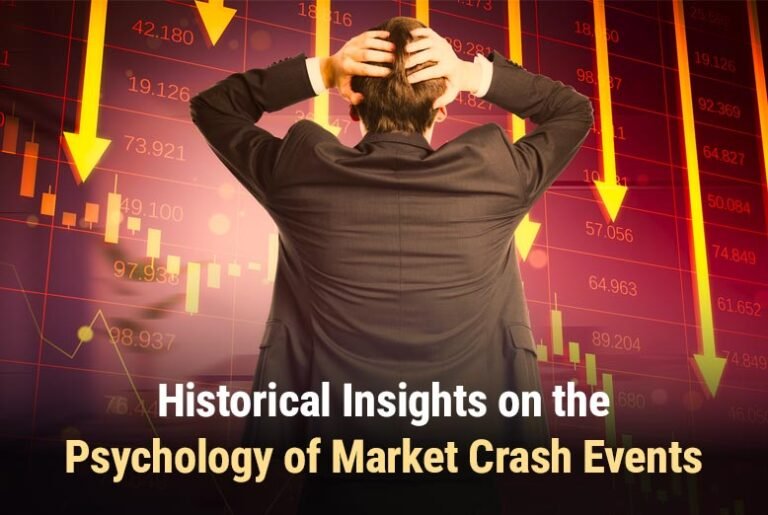Boom-bust cycles have always been common in financial markets. Although global events, governmental policies, and economic foundations frequently cause crashes, the human psyche is just as important. Fear, greed, and herd mentality are common ways that investors amplify downturns and transform corrections into full-fledged market crises.
For traders, investors, and policymakers, understanding the psychology of market crashes is not only fascinating but also crucial. Numerous examples from history demonstrate how emotions influence group decisions and cause sharp fluctuations in financial markets.
Market Crashes’ Emotional Underpinnings
Rarely do market crises happen in a vacuum. They typically arise when a generalized sense of optimism degenerates into terror. This process is influenced by human psychology in multiple ways:
- Bubbles are fueled by greed, as investors ignore hazards in pursuit of higher prices.
- Fear speeds up selling: When there is even a slight drop, fear sets in and everyone rushes to get out.
- Herd behavior spreads contagion: Individuals follow the pack, believing others know better.
- Confirmation bias impairs judgment because people look for information that confirms their positive or negative viewpoint.
In extreme cases, such as a bitcoin crash scenario, these psychological tendencies can be magnified, with rapid panic-selling cascading across exchanges and magnifying losses.
These inclinations produce cycles that reinforce themselves. Once a downturn starts, pessimism frequently triumphs over reason, resulting in a downward price spiral.
Insights from the Great Depression of 1929
The Wall Street Crash of 1929 remains one of the most researched financial crashes in history. A huge stock market bubble was fueled in the years preceding it by optimism about economic development and new technologies. With the belief that prices would only grow, ordinary people—not just the elites—borrowed money to invest.
Panic spread quickly when prices started to drop. The downward trend was accelerated by margin calls, which compelled investors to sell at any price. Due to widespread withdrawals, even thriving banks and companies failed as a result of the nation’s fear of complete financial catastrophe.
This illustrates the psychological lesson that unbridled optimism and leverage lead to weak systems. When trust is gone, fear takes precedence over principles, causing significant and long-lasting harm to the economy.
Euphoria Among Investors and the Dot-Com Bubble
When the dot-com boom burst in the late 1990s, history was repeated. Because investors thought the internet would change the world, technology stocks skyrocketed. However, this did not happen as quickly as the markets had anticipated. The billions were used to value a lot of businesses that had no income or workable business plans.
The bubble popped when reality struck in. Between 2000 and 2002, the Nasdaq plummeted by about 80%, wiping out trillions of dollars in wealth.
One of the most important lessons learned during this time is that investor excitement frequently causes valuations to become disconnected from reality. Traders convinced themselves that “this time is different” and concentrated more on storylines than fundamentals. Because it implies a communal ignorance to risk, this word has historically been used to indicate peril.
Global Financial Crisis of 2008: Fear and Trust
Another aspect of psychology that was brought to light by the 2008 financial crisis was trust. Mortgage-backed securities that were packaged and sold by financial institutions were far riskier than they had been claimed to be. Market and bank confidence vanished as defaults increased.
Ordinary folks worried as homes lost value and jobs vanished, while investors sold assets in a haste to escape danger. To regain confidence, governments from all around the world intervened with stimulus plans and bailouts.
This catastrophe demonstrated the psychological fragility of faith in financial systems. Once individuals distrust the integrity of markets or institutions, fear spreads quicker than reason.
The Herd Behavior and the COVID-19 Crash
As COVID-19 spread, global markets had one of the quickest falls in history in March 2020. The anxiety was existential as well as financial. In a desperate attempt to raise money, investors sold everything from stocks to safe-haven assets like gold.
Markets fell more than 30% in a matter of weeks. But just as panic selling caused prices to drop, a swift recovery was brought on by coordinated central bank and government stimulus measures. This “V-shaped recovery” demonstrated the speed at which market sentiment can change from pessimism to hope.
Key Psychological Patterns Across Crashes
Despite the fact that every crisis has its own set of causes, several psychological patterns have persisted throughout history:
- Overconfidence before to the collapse: When earnings appear straightforward, investors disregard warning indications.
- Fear of missing out (FOMO): Latecomers are drawn to the top of the price scale by rising prices.
- Panic and surrender: Often at the worst conceivable moment, a tipping point triggers widespread selling.
- Loss of faith and blame: Investors start to doubt organizations, authorities, and even the financial system itself.
These trends demonstrate that markets are reflections of human behavior rather than just logical mechanisms.
Lessons for Today’s Traders and Investors
Anyone navigating today’s financial markets can learn a lot from comprehending the psychology of market crashes. Traders can avoid becoming overwhelmed by volatility by understanding how emotions impact behavior and preparing for it.
- Among the useful lessons learned are: Keep an eye on the big picture to prevent emotional responses to short-term decisions.
- Limit the impact of panic-driven markets by setting stop-losses and position sizes.
- Examine past crashes to identify recurring trends.
- Portfolios should be diversified to lessen their exposure to single points of failure.
Successful investors are frequently distinguished from those who suffer the most during downturns by their capacity to remain composed when others panic.
Both psychology and economics play a role in market crashes. History demonstrates how herd mentality, fear, and greed intensify downturns, from the Great Depression to the COVID-19 pandemic. Technology booms, housing crises, and worldwide pandemics are examples of different triggers, yet the fundamental human emotions are strikingly constant.
Also Read; Why the Breadth of Market Movement Matters for Long-Term Investors



